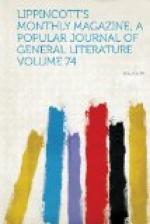It is years since so lovely an autumn as that of 1874 has been seen in Europe: people say not since the last great comet year, and they credit the erratic visitor of last summer with the exceptional beauty of the weather. As in the case of other marked comet years, the vintages of which still bring extraordinary prices, Italy has had exceptionally fine harvests of all kinds this year. The grain has been abundant, the vintage has been superb, the olives have escaped the danger of unseasonable frosts, and the still more important crop of foreigners seems to be pretty well assured. The charming weather in October and November made the interesting blossoms sprout plentifully; and boat-loads and train-loads came in with an abundance promising an unusually fine winter for la bella Italia. Venice, indeed, may be said to have pretty well housed her crop in this kind already. It has been a magnificent one, and the Queen of the Adriatic admits that due homage has been done to her. The forestieri season sets in earlier in her case than in her sister cities. The real “Carnival de Venice” is in August, September and October now-a-days, let the calendar say what it may. Some flaunting of gaudy-colored calico, some dancing on the Piazza of St. Mark, there may be on the eve of Lent in obedience to old usages, but the dancing that really glads the Italian heart is the dancing for which the forestiere pays the piper, and the true Lenten time is that when his beneficent presence is wanting.
Venice, then, has already brought her Carnival to a conclusion; and it has been a splendid one. English, Americans, Germans, all came in shoals—all thronged the galleries, the churches and the palaces in the morning, sauntered or bathed on the outer shore of the Lido in the afternoon, and met at Florian’s in the evening. “What is Florian’s?” will be asked by those who have never been at Venice—by some such, at least. For probably the fame of the celebrated caffe may have traveled across the Atlantic, just as many who have never crossed it westward are no strangers to the name of Delmonico. Florian’s, however, in any case, deserves a word of recognition. It is the principal, largest and most fashionable caffe on the Piazza di San Marco. But the singular and curious specialty of the place is that it has never been closed—no, not for five minutes—day or night, for a period of more than a hundred and thirty years! Probably it is the only human habitation of any sort on the face of the globe of which that could be said.
But the caffe in itself is in many respects a specialty of Venetian life, and has been so since the days of Goldoni. The readers of his comedies, so abundantly rich in local coloring, will not have failed to observe that the caffe plays a larger part in the life of Venice than is the case in any other city. Probably no Venetian passes a single day without visiting once at least, if not oftener, his accustomed caffe.




